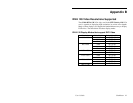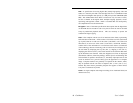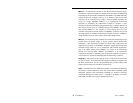
CineMaster User’s Guide48
MPEG-1 –
A international standard of the Moving Picture Experts Group,
describing a compression method for digital video and audio. By eliminating
both temporal and spatial data redundancies, the MPEG-1 algorithm drastically
reduces the data size of digital video. Up to 72 minutes of full motion video
and audio can be compressed (up to 200:1) using the MPEG algorithm and
stored on a single CD-ROM. MPEG-1 is an asymmetrical compression
algorithm, so performing the computations required to compress a video
sequence is much more demanding than decompressing a sequence. Because of
this, pictures are not stored as individual images in the MPEG-1 stream, and
fully encoded MPEG-1 is not suitable for video editing. Also the lower
resolution (one-quarter broadcast quality) of a MPEG-1 stream will not provide
the image quality of an JPEG encoded image with full resolution. A MPEG-1
stream includes video I, P, and B frames and an audio MPEG stream.
MPEG-2 –
An broadcast-quality standard, also named after the Moving Picture
Experts Group, for generic coding of moving pictures and associated audio
information. This international standard for digital video compression and
digital television, builds on the MPEG-1 standard to support larger image sizes
and better image quality for use in professional and consumer applications.
Due to this higher image quality, MPEG-2 was chosen as the compression
method to be used for DVD. MPEG-2, like MPEG-1, is an asymmetrical
compression algorithm, so performing the computations required to compress a
video sequence is much more demanding than decompressing a sequence.
Navigation –
The process of accessing the parts of a DVD data stream that are
not video or audio. Navigation data and navigation commands are supported in
the DVD specification, and are the mechanism that provides unique DVD
features such as interactivity and direct random access.
NTSC –
National Television Standards Committee of the Electronic Industries
Association, or their standard for video. This United States committee, which
determines technical and broadcasting standards for domestic television,
created the definition for NTSC video
720
×
480 at 30 frames per second.
(The NTSC standard is also used for Japanese television.)


















